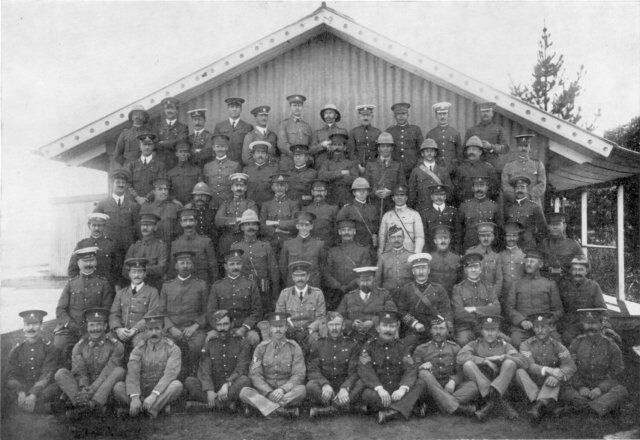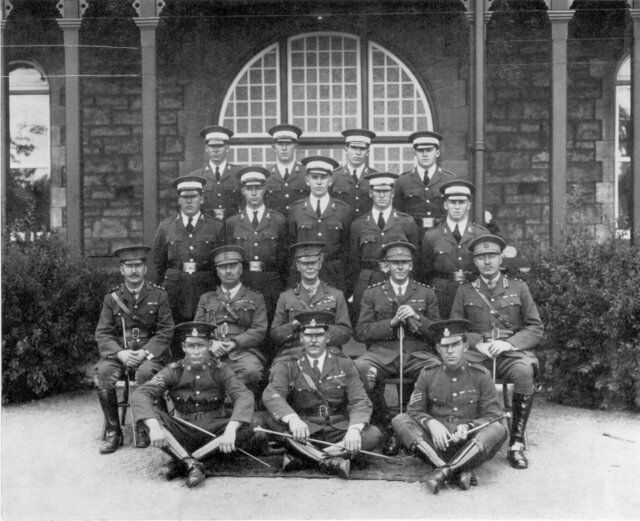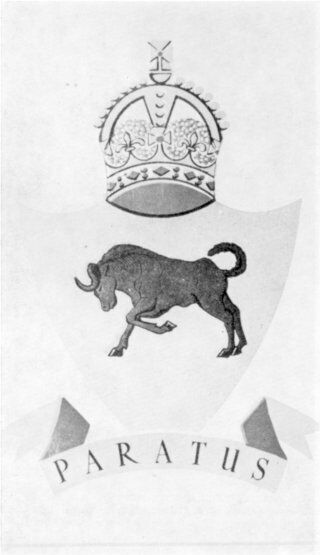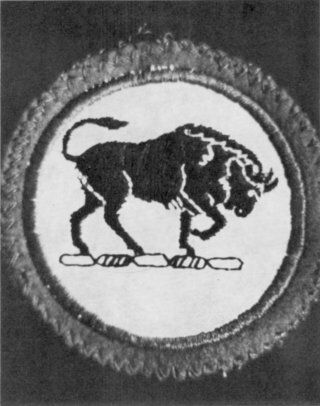

 The South African
The South African
"Since the dawn of history man has practised war, and throughout the ages we read of military schools where the art of war was taught and studied. These old military schools of the Middle Ages prospered and they grew, for man - we marvel at the suppleness of his will, the adaptability of his mind - came to accept war as inevitable, as a relentless law, as wicked and dangerous as thunder from the clouds above. But he was not to be outwitted and so, in order to guard against the evils of war, man prepared for war. In this way military academies have developed in all the continents of the world. These institutions have always concerned themselves primarily with the training of leaders." - From a college publication.
Introduction
A country, which desires to ensure its continued existence and to distinguish itself, must give continual attention to the establishment and development of its military organisations. Integral components of these organisations are schools, colleges and academies, aimed at training corps of officers and instructors. For many years these have been uppermost in the thoughts of South Africa's military leaders; hence the establishment of various training schools, three colleges and an academy. This article deals with the South African Army College.
Early attempts in South Africa
The need for improving the military knowledge and qualifying military leaders for their task in South Africa was realised at the very outset. Thus it was that the Dutch East India Company decided in 1786 to establish a training centre in South Africa for military cadets, selected from the local population. Governor van der Graaff was instructed to establish a "Militaire Kweckschool" at which cadets were to receive their training under the authority of the officer in command of the artillery. Special attention was to be given to the study of arithmetic. However, the school did not reach the stage where it functioned properly, owing to the financial difficulties and eventual collapse of the Dutch East India Company.
The S.A. Military College established
The next moves towards the establishment of a military college in South Africa were taken after Union in 1910. In Chapter IV of the South Africa Defence Act, 1912, provision was made for the establishment of an institution to be designated the South African Military College (Zuidafrikaanse Militaire School).
It is interesting to note here that, although the institution was designated a college in the English version of the legislation, it was more accurately termed a "school" in the Dutch. In the Annual Reports of the Department of Defence and Executive Commands for the year ended 30 June 1913, the College was referred to as "an institution or group of institutions, known as the South African Military Schools." The report added that the institution "... is not a military college in the sense that Woolwich and Sandhurst in England, West Point in America, Kingston in Canada and Canberra in Australia, are military colleges, i.e. for giving a consecutive course of military and other instruction for two years or so to young men desiring to take up the military profession as officers."
At first the only branches of the College which were in existence were the General Branch (styled the South African Military School) and the Musketry Branch (called the South African School of Musketry).
The S.A. Military School was established on 1 July 1912 at the Old Presidency in Bloemfontein. On the same date, a class of 51 officers assembled there to attend a course. The Old Presidency had been selected to accommodate the Military School until such time as buildings, which were more suitable, became available at Tempe just outside Bloemfontein.
On 1 April 1913, the S.A. School of Musketry was opened as a separate institution at Tempe and the first course, for rifle instructors, began on the 13th of that month. The School of Musketry later became the nucleus of the Weapon Training Branch of the College.

Lt. M.H. Pike. Lt. E.E.F. Simkins. Lt. W.M. Stewart. Capt. J.H. Breytenhach.
Maj. V.M.B. Scully. Lt. P.V.G. van
der Byl. Lt. C.O. Rutherfurd. Capt. H.A. Hirsch.
Maj. F.A. Jones, D.S.O. Maj. G.G.H. Helbert. Maj. E.F. Thackeray.
Capt. L.F. Collender. Lt. G.J. du Preez. Maj. W.E.C. Tanner. Lt. A.N. Nussey.
Capt. F.T. Dickerson.
Lt. J. Joubert Pienaar. Maj. W.L. Harvie. Lt. R.W.E. Stopford.
Lt. J.B. Row. Sgt.-Major C.H. Layzell.
Capt. W.F.P. Groves. Capt. J.J. Pienaar. Lt. S.G. Martiz. Capt. Ben Bouwer.
Maj. G.M. de Waal.
Maj. J.L. Pretorius. Lt. J.G.W. Leipoldt. Capt. G.T. Suttie.
Lt. F.E. Watermeyer. Lt. A.J. Taylor. Capt. C.W. Lewis.
Maj. G.R. Richards. Capt. I.P. Vlok. Lt. J.H. Snyman. Lt. M.J. de Jager.
Lt. F. Esselen. Capt. H.C.V. Grothaus. Capt. G. Hodgson, Capt. R.W. McCluskie,
Maj. E.T. Humphrys. Lt. C.M. Tippetts (Assnt. Instr). Lt. H.S. Oberholzer.
Maj. T.H. Blew. Maj. F. Moore (Chief Instr.). Capt. T.C. Nieuwoudt.
Lt. Col. J. Lewis, C.M.G., V.D. Lt. Col. A.J. Carter, D.S.O. (Commandant).
Capt. G.A. Brand. Lt. Col. E. Smedley Williams. Capt. G.H. Giles (Assnt. Instr.).
Lt. A.J. Brink. Capt. J.C.G. Kemp.
Q.M.S. J. Bostock, S.I., F. Lewis, P.S.S., E.J. Morse, S.I., E.W. Merrett, S.I.,
W. Godwin, S.I.,
W.E. Butler, A.S.S., G.A. Leonard, S.I., J. Pegden, S.I.,
O. F. Carter, R.S., E.T. Ephgrave, C.S.M.I., A. Aitken.
W. FRAY (Photo). Tempe
Concentration of various establishments
The arrangement, whereby the schools were situated a distance from each other, proved to be impractical. As a result, the various training establishments in the Bloemfontein area were transferred to Tempe on 1 January 1914 and placed under the command of Lieutenant-Colonel P. C. B. Skinner. To this organisation was given the name of the South African Military Schools. It was composed of a School of General Military Instruction, a School of Musketry, a School of Signalling and a Medical Training School.
World War I arrangements
Following the outbreak of the First World War, the establishment at Tempe was closed and the staff transferred to the mobilisation camp at Potchefstroom early in 1915. During the war years, they were employed in training specialists and volunteers for service with the overseas contingents. Thus came to an end the second attempt to establish a military college in South Africa.
Established at Roberts Heights
In 1920, the College was re-established in the now familiar stone building at Roberts Heights (now Voortrekkerhoogte) and designated the South African Military School. Colonel W. E. C. Tanner, CB, CMG, DSO, was the Commandant.
The College building
Lord Kitchener was responsible for the original planning of the building and laid the foundation stone on 12 June 1902. The actual building operations were carried out by the Royal Engineers. Dubbed "Kitchener's Folly" at one stage, the building was to prove extremely useful later. During the First World War, it was used to accommodate the overflow of patients from the Military Hospital.
The whole of the Roberts Heights area, with all the buildings thereon, was transferred to the Union Government by the Imperial Government after the First World War, as a gift. In addition to the main building, there was also a gymnasium in the grounds. This was destroyed by fire in 1922 and was replaced by a smaller gymnasium which is still in use.
Post-war development
On re-establishment, the School consisted of the "G' Branch, the Musketry Branch, the Signals Branch and a Training Depot. After March 1920, the real development of the College took place. By June of that year, military training was in full swing.
The South African Air Force was established in 1920 when Colonel H. A. van Ryneveld was appointed Director of Air Force Training on 1 February. The Military School was physically involved in the formation of the Air Force, in that the Training Depot supplied the personnel for guarding the flying equipment, brought from abroad that year, on the site where Swartkop Airfield was later built. Closer ties with the Air Force followed in later years when Air Force cadets received part of their training at the School.
College status accorded
In 1923, a significant step was taken when 12 cadets commenced a course for commissions in the South African Permanent Force. As a result, college status could not be withheld from the Military School and, on 1 July 1924, it became the South African Military College. A second course for Permanent Force cadets began on 6 August 1924.
Air Force cadet training
On 4 January 1926, ten students reported for the first Air Force cadet course to be conducted at the South African Military College. A second course for Air Force cadets began at the College in 1927.

Left to right: Cadet M.C.P. Mostert. Lt. H. H. Klopper. Lt. P. W. A. Nel.
Cadet H. L. Bronhorst. Capt. J.J.C.
Venter. Cadet P. M. Murdock.
Cadet J. Donald. Cadet J.E.O. Marais. Cadet J.D.K. Louw.
Sitting: Capt. G.A. Reid (Signalling Branch). Maj. A.J.F. Prins, D.T.D., D.S.O. (Officer
Lecturer),
Lt. Col. E. Christian, D.S.O., M.C. (Commandant). Capt. G.E. Brink, D.S.O. (Adjutant). Lt. D.J. Roux (Musketry).
Sitting on ground: Sgt. C.E. Brits. S.M.I. L. Higginbotham. S/Sgt. J.H. Barnard.
Photo by KASSEL BROS., Krugersdorp.
Combined training
Another course for Army cadets of the Permanent Force commenced in 1929. This course was amalgamated with an Air Force cadet course early in 1930, after it had been decided that cadets would in future receive combined training for service in the Infantry, Artillery and the Air Force. This training system continued until the outbreak of the Second World War in 1939.
This policy of combined training resulted in the appearance among South African officers of individuals who sported both spurs (horse gunners) and wings.
Physical training
In 1923, the Impecial Government had provided well-qualified instructors for a series of courses in Physical and Recreational Training. These efforts did not meet with success and physical training was relegated to the background.
In 1936 and 1937, an awareness of the necessity for this form of training again became evident and a deputation was sent to Europe to investigate the matter. As a result, the Physical Training Branch was established on 1 May 1938.
Outbreak of World War II
War broke out on 3rd September 1939, giving the College its first experience of training soldiers under conditions of conflict. It is worth recording that in the year coinciding with the outbreak of the war (from June 1939 to June 1940), 9 170 students passed through the College, while at the peak period (in March 1942) there were 1 800 students of all ranks on courses simultaneously. During the war, about 150 000 men of all ranks passed through the College.
The war years
Late in 1939, the following five additional branches were established at the College:
(a) Commando Training .. .. .. .. .. .. .. 31 October
(b) Concealment and Camouflage .. .. 14 November
(c) Chemical Warfare .. .. .. .. .. .. .. .. 22 November
(d) Armour Branch .. .. .. .. .. .. .. .. .. 27 November
(e) Regimental Training .. .. .. .. .. .. .. 1 December
The Commando Training Branch was transferred to Ladysmith in 1940 and the Armour Branch to Kafferskraal shortly afterwards. Also in 1940, the Signals Branch moved from the College to Potchefstroom where it became the Signals Training Centre, this name being changed to School of Signals in 1944. The School of Signals again became a branch of the College in 1946 and, in January 1947, it was once more moved to Potchefstroom where it became a branch of the School of Artillery and Armour.
The Chemical Warfare and the Concealment and Camouflage Branches were disbanded in 1945. In April 1945, the Regimental Training Branch became incorporated with the Weapon Training Branch.
Post-war developments
The Administration and Ordnance Branch was established on 19 July 1950. In the same year, the Defence Force Academy Branch was established. In collaboration with the University of Pretoria, this branch undertook academic training of both Army and Air Force cadets. The joint training of Army and Air Force cadets at the College was terminated on the establishment of the Air Force College on 7 December 1951.
Infantry School established
In the second half of 1953, provision was made for the Weapon Training Branch to be renamed the Infantry School. This School remained an integral part of the College and its first establishment table was set in January 1954.
Regimental Colour
Another important date in the history of the College is 31 May 1956. On that date the Minister of Justice, Mr. C. R. Swart, presented the College with its Regimental Colour.
Colours are often donated to military units by various organisations but, in this case, the staff of the College obtained a Colour by their own efforts. Preparations to obtain a Colour were started in 1939 when the Cabinet approved in principle. It was not until 1948 that active steps were taken. In that year a design was submitted to the Adjutant-General for approval, but drastic changes were made before it was finally accepted. The material for the Colour was woven specially in France while the embroidery and other work were done by Mrs. M. T. Steyn of Pretoria. The Springbok on the stinkwood pike was cast by the sculptor, Hennie Potgieter.
About 400 men, representing 78 Citizen Force units, took part in the parade which accompanied the presentation ceremony. Major-General H. B. Klopper, DSO, Inspector General, and Brigadier P. H. Grobbelaar, uso, Army Chief-of-Staff, were on the saluting base with the Minister of Justice. After the presentation, there was a short break followed by the most impressive ceremony of the afternoon - the Trooping the Colour. The Trooping was done by four guards of 66 men each, with the Army Band providing the music. The Colour Ensign was Lieutenant C. J. Lloyd.
Padré John A. Gurney, who was Principal Chaplain of the Free Churches, consecrated the Colour which was then lodged in the officers' mess at the College. Since the College has no battle honours, none appears on the Colour. The tassel and fringe are of gold braiding. The background is the same as that of the national flag - orange, white and blue bands of equal width. The College badge, a wildebeest, is embroidered on a blue background on the white hand of the Colour and is encircled by two laurels of pink proteas with green leaves. The motto "Paratus" is embroidered in gold on a scroll of old gold below the unit badge.
Cap badge
The College also had its own cap badge. It consisted of a white metal shield, surmounted by a King's crown of brass.

Cap badge adopted by the College in 1924
but not in use since circa 1957
Further developments
The Administrative and Ordnance Branch left the College to become the Services School on 2 January 1962. At the Services School, which is situated across the road from the College, the basic and advanced training programmes for members of the Administrative Services Corps, the South African Medical Corps and the South African Corps of Military Police have been combined under one roof.
The Intelligence Branch was established on 1 January 1963. Also in 1963, the Nuclear, Biological and Chemical Branch was established on 1 April and commenced its first course on 31 August of the following year. The Infantry School became a self-accounting unit on 1 October 1963, a separate unit on 16 November 1963 and prepared to depart for Oudtshoorn before the end of that year. (The author was a member of one of the last courses held at the Infantry School at Voortrekkerhoogte and took part in the departure preparations). The Infantry School held a farewell parade at the College on 16 November 1963.
Shoulder flash and motto
On 16 March 1963, the staff of the College appeared on parade, wearing their new shoulder flash for the first time. The flash is round and consists of an outer ring of blue with an inner ring of maroon. The inner background is white upon which is superimposed a wildebeest in black.

Shoulder flash of S.A. Army College introduced in 1963
Army College established
On 1 March 1968, the Chief of the Army, Lieutenant-General W. P. Louw, SM (a former Commandant of the College), announced that it had been decided to change the name of the South African Military College to the South African Army College. The Minister of Defence, Mr. P. W. Botha, had approved the change because the College had taken on an army character with the establishment of the Air Force College in 1951. The change in designation was, therefore, a logical consequence.
At the same time, the title of Commandant of the Military College was abolished and the title of Officer Commanding, South African Army College, introduced. The Military Academy at Saldanha Bay is the academic training centre for the three arms of the Defence Force.
Conclusion
Situated about 10 kilometres from Church Square in Pretoria, the Army College is surrounded by the military suburb of Voortrekkerhoogte. It is an inspiring sight and gives the impression of a restful stateliness - a stateliness of "Paratus".
Author's Note: I am deeply indebted to the Officer Commanding the College and his staff for their kindness and patience in answering queries and supplying material for the compilation of this article.
Return to Journal Index OR Society's
Home page